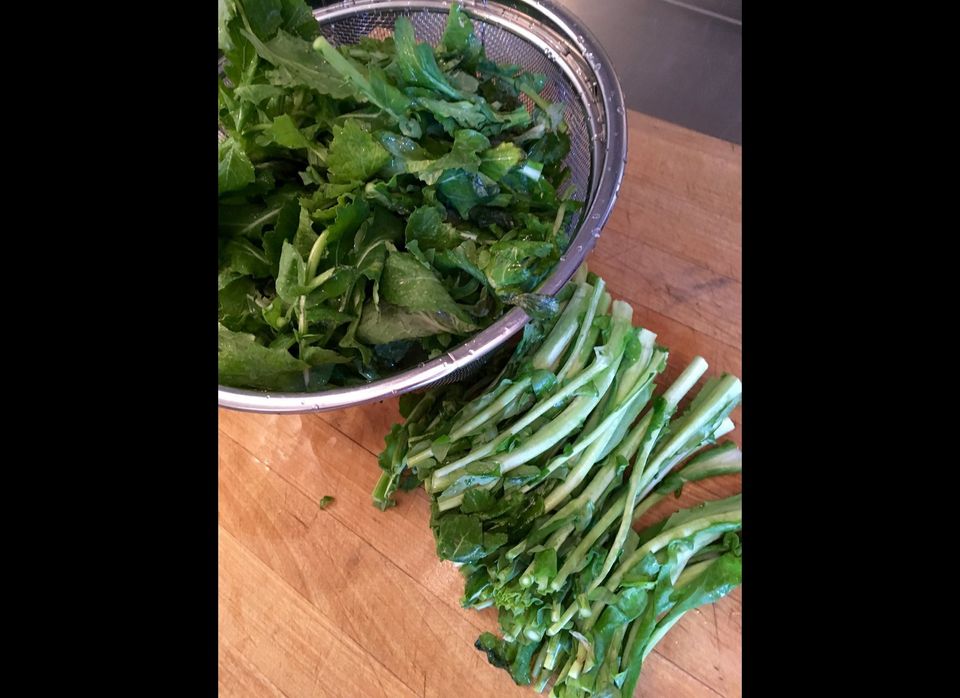After three and a half weeks of travel, Jackie and I were eager to make our way down to New York's Union Square farmers' market to see what springtime wonders had sprouted since our departure for vacation. The answer was "not many," which, while disappointing, wasn't really a surprise: we still needed hat and gloves as we walked, so spring had clearly not arrived.
But "not many" does not mean none: In addition to eggs, a chicken, over-wintered parsnips and what not, we bought a sparkling fresh bunch of broccoli rabe, a member of the mustard/turnip family known also as rapini, broccoletti, friarielli and cime di rapa, among many other regional names. We usually eat it with pasta, and we did just that on the first night, with guanciale, a little garlic, dried chilies, sage and grated pecorino. This used something less than half of our bunch of greens.
Their affinity with pasta made me wonder about how they'd work with rice, not cooked in a Chinese way and served with rice, but integrated into a risotto. As I imagined it, it didn't really resonate, so I sought validation on the Internet and got more than 100,000 hits for "risotto cime di rapa" alone. Many of the references were to dishes including meat or seafood or to "healthy" risottos of unappetizing austerity, so I devised my own approach, not dissimilar to ones I've used for other vegetable risottos: pureeing part of the cooked vegetable and enriching the rice with this "sauce"; and cutting the rest into small pieces that add texture to the finished dish.
I had par-cooked the broccoli rabe as soon as we got it home: Cutting across the bunch, I separated the leafy tops from the thicker stems and washed everything. I cooked the stems in a big pot of boiling salted water for about 90 seconds, then added the leaves (and their thinner stems) and cooked for less than a minute more - until just after the water had come back up to the boil, in fact. It all went into a big bowl of cold water to cool quickly; I squeezed out much of the liquid and packed the nearly-cooked greens into a container for storage in the fridge.
Before I started the risotto, I sweated a minced shallot in olive oil, rough-chopped the greens and added them to the pan with some salt to cook a little more and take on additional flavor; a half-clove of garlic would have been an option here. I pureed a big handful of them using an immersion blender, then used a spoon to scrape them through a strainer to remove the tougher fibers (note, by the way, that these greens are tender to eat but tough to a blender's blades). I made the risotto in the usual way: shallot sweated in butter or oil, rice (vialone nano today, 2/3 cup - 150 g - for the two of us) stirred in, white wine, then dilute vegetable stock added as absorbed - and constant vigorous stirring. When the rice was nearly done, I added the chopped greens, and when it was completely done I energetically stirred in the broccoli rabe puree, a tablespoonful (15 g) of butter and a couple of ounces (say, 50 g) of a flavorful but not sharp cheese with good melting qualities. I used Pawlet from Consider Bardwell Farm in Vermont; fontina or taleggio would be excellent choices too). As usual, I then covered the pan and let the risotto sit for two or three minutes before a final stir and a last-minute taste (it needed a drizzle of stock to keep it fluid). I served it with grated parmesan at the ready to make its own savory contribution. (This is a good moment to remind you: warm the plates before serving up your dinner, especially if you're planning on risotto or anything else whose consistency would be affected by a cold plate.)
Even though the broccoli rabe wasn't as sharp-tasting as some I've eaten, its slight bitterness and mild bite made this an unusual and successful risotto. It would work well as a satisfying first course, yet it held our interest in a main-course portion. And as an early hint of the springtime produce to come, it even lifted our spirits, which is pretty good for a plate of rice and greens.
